by Taylor Vandiver | Apr 29, 2014
Now that spring has finally sprung and summer is well on its way, you may find yourself taking a stroll through your landscape and assessing damage done by late cold spells. However, it may not be a frost problem that has your plants looking worse for the wear. They could be experiencing nutritional imbalances which affect overall plant health. Most cases involving nutrition issues in plants can be linked back to the soil. Therefore, if you suspect a problem I suggest testing your soil to ascertain pH and nutrient levels. You can obtain a soil test kit at your local UF IFAS Extension office. Another way to diagnose your plant damage is to visually catalog its symptoms. Symptoms of mobile nutrients, such as nitrogen and phosphorus, tend to reveal themselves on older leaves first. Whereas, immobile nutrient symptoms (i.e. boron and calcium) will show up on newer leaves. These flow charts can help to narrow down which essential element may be lacking in your plant’s diet.
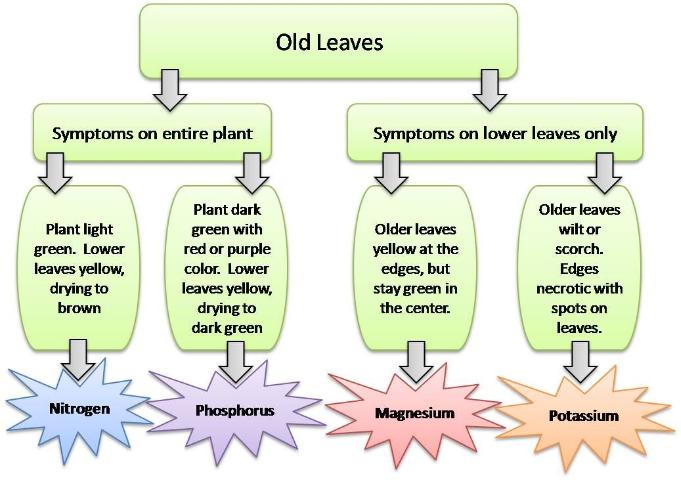
Mobile Nutrient Symptoms.
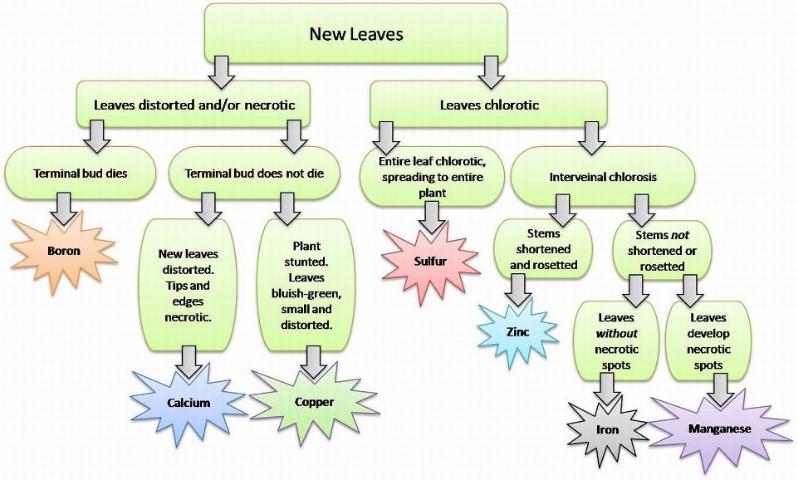
Immobile Nutrient Symptoms.
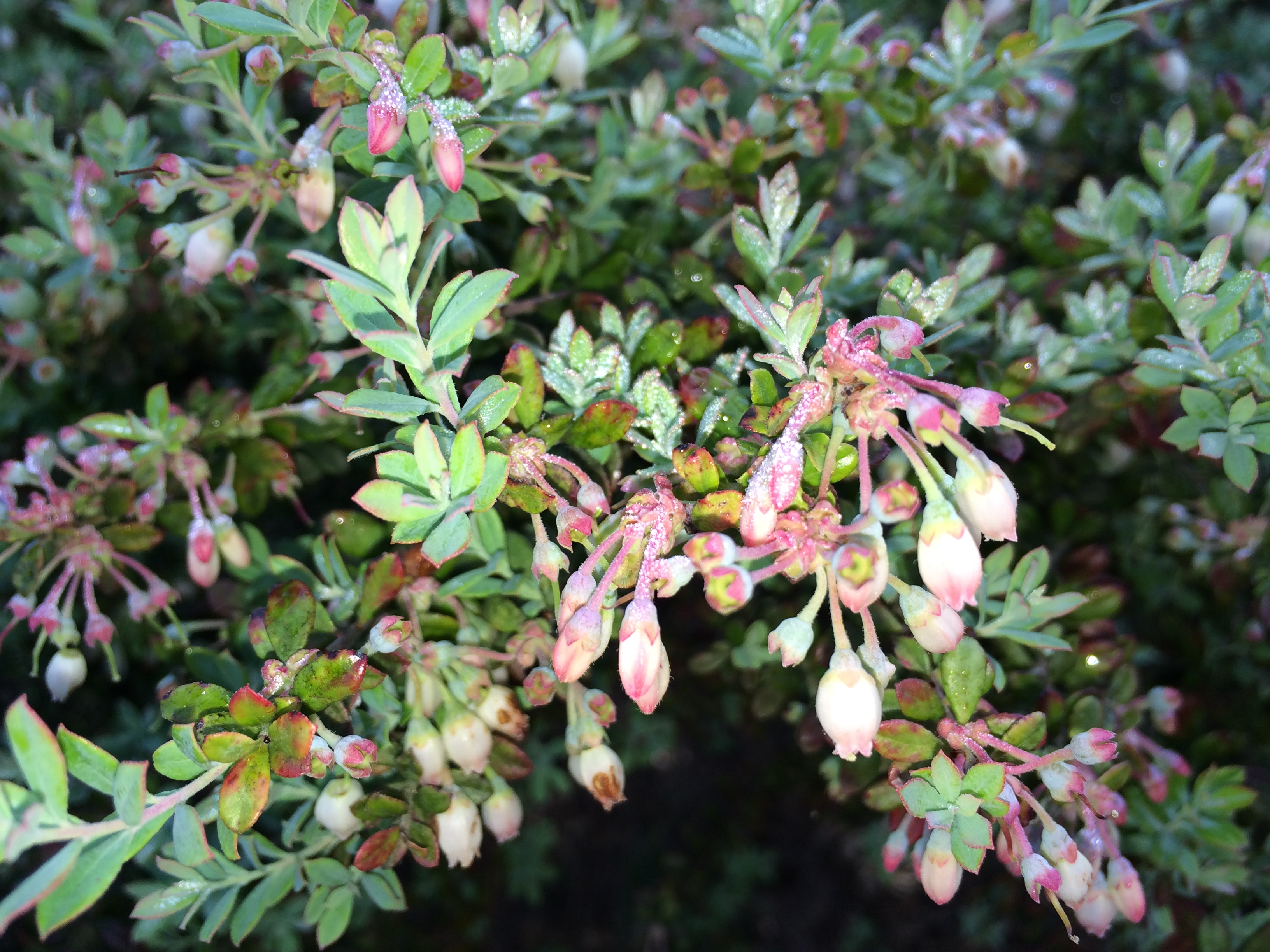
by Mary Salinas | Apr 15, 2014
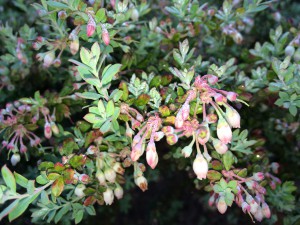
Darrow’s Blueberry with spring blooms. Photo credit Mary Derrick UF IFAS.
A blueberry bush as a landscape shrub?
Yes! Darrow’s blueberry, Vaccinium darrowii, is closely related to the other blueberries you know and love, but this little gem of a shrub is highly ornamental and will fit in with any landscape scheme.
This compact shrub stays usually stays under three feet tall and wide, making it a perfect size for the home landscape. The small evergreen leaves emerge with a delightful pinkish tinge. In spring, pinkish white small flowers emerge and are followed by small but delicious blueberries. This blueberry will self-pollinate and set fruit, but studies have shown that there will be a sizable increase in fruit set if another variety of blueberry is close by for cross-pollination.
Darrow’s blueberry is a Florida native so it is perfectly adapted to our environmental conditions. Once established it has a moderate drought tolerance. Like other blueberries, it likes full sun, requires acidic soils with a pH between 4.0 and 5.5, and prefers the addition of organic matter into the planting bed if the soil is quite sandy. Pests are usually not a problem except for competition for the ripe fruit from wildlife.
If needed, there are several fertilizer options for blueberry; a 12-4-8 with 2% magnesium, a “blueberry special” formulation or a fertilizer formulated for camellias and azaleas. Whichever you use, apply the fertilizer lightly and widely spread around the plant– only about one ounce per plant every 2 months during the growing season April through October. Blueberries can be easily killed by too much fertilizer.
For more information, please see:
Blueberry Gardener’s Guide
Gardening Solutions: Blueberries
Florida Native Plant Society: Darrow’s Blueberry
Creating an Edible Landscape
by Matthew Orwat | Apr 8, 2014
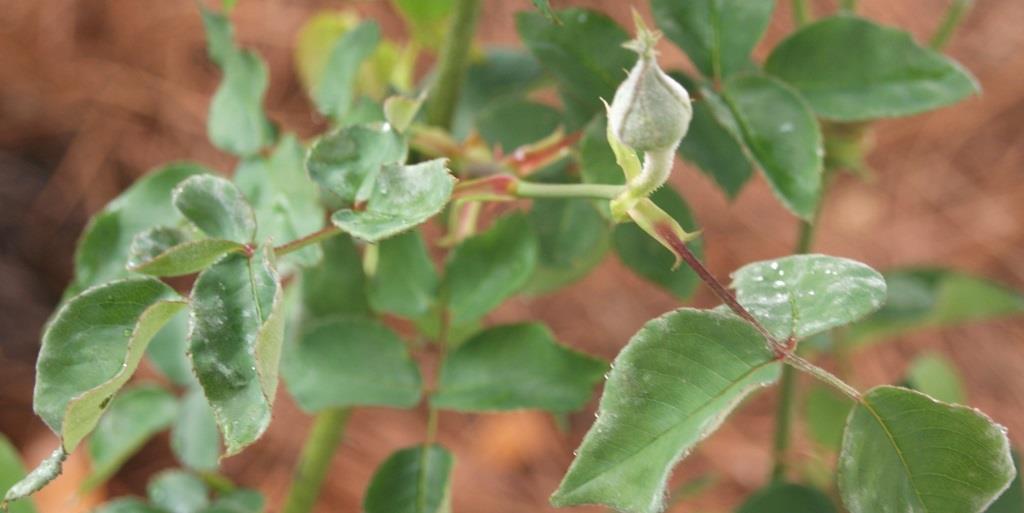
Powdery mildew on rose bud. Image Credit Matthew Orwat.
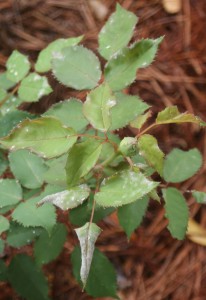
Powdery mildew on rose leaf. Image Credit Matthew Orwat.
This spring powdery mildew has been prevalent on many non-resistant cultivars of ornamental plants, particularly rose and crapemyrtle.
Ideal conditions for powdery mildew development, warm days and cool nights followed by rain, have been present for several weeks in Northwest Florida.
This fungus, which looks like powdered sugar and is caused by several different species, appears on new growth and causes distorted and stunted leaf and flower development. It grows in thin layers on the surface of leaves and reproduces by spores.
Mild cases are of little concern, as most plants will grow out of it once environmental conditions change to be less favorable for development of the pathogen. Severe cases can cause distorted growth, leaf drop and flower destruction.
In these cases, fungicide application will protect new growth from this disease. Some lower toxicity fungicides that have been shown to have effectiveness on powdery mildew include neem oil and potassium bicarbonate (otherwise known as Baking Soda).
Sulfur can be used, but cannot be applied when temperatures reach above 90 ° F. Other chemical fungicides, including those containing myclobutanil, or azoxystrobin can be used but products obtained must be labeled for ornamental use. Remember, the label is the law.
Many disease resistant cultivars of rose and crapemyrtle exist, please follow the links provided for more information.
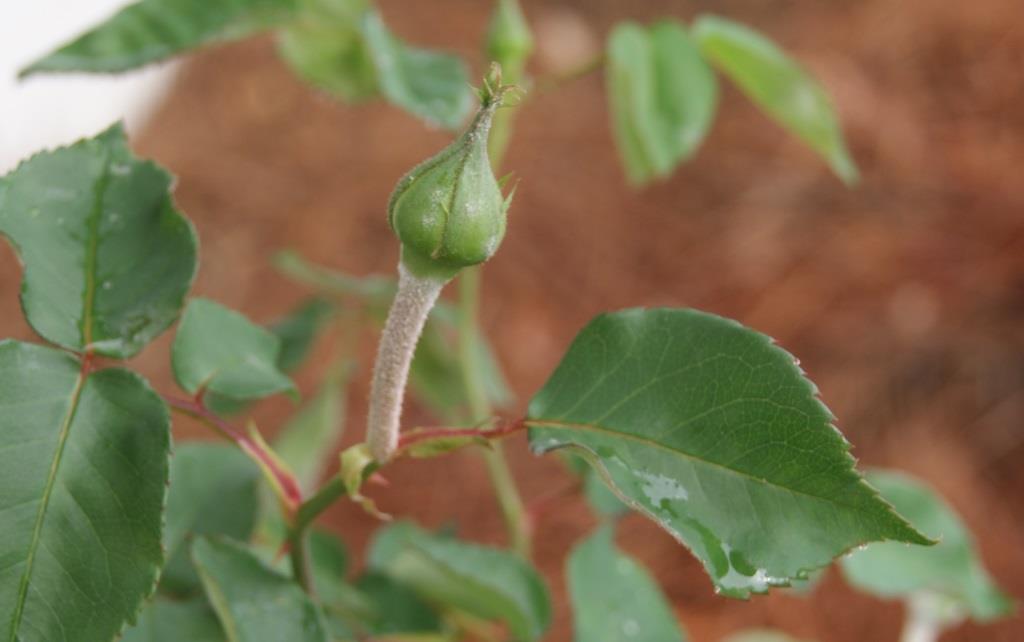
Powdery mildew on rose petiole. Image Credit Matthew Orwat.
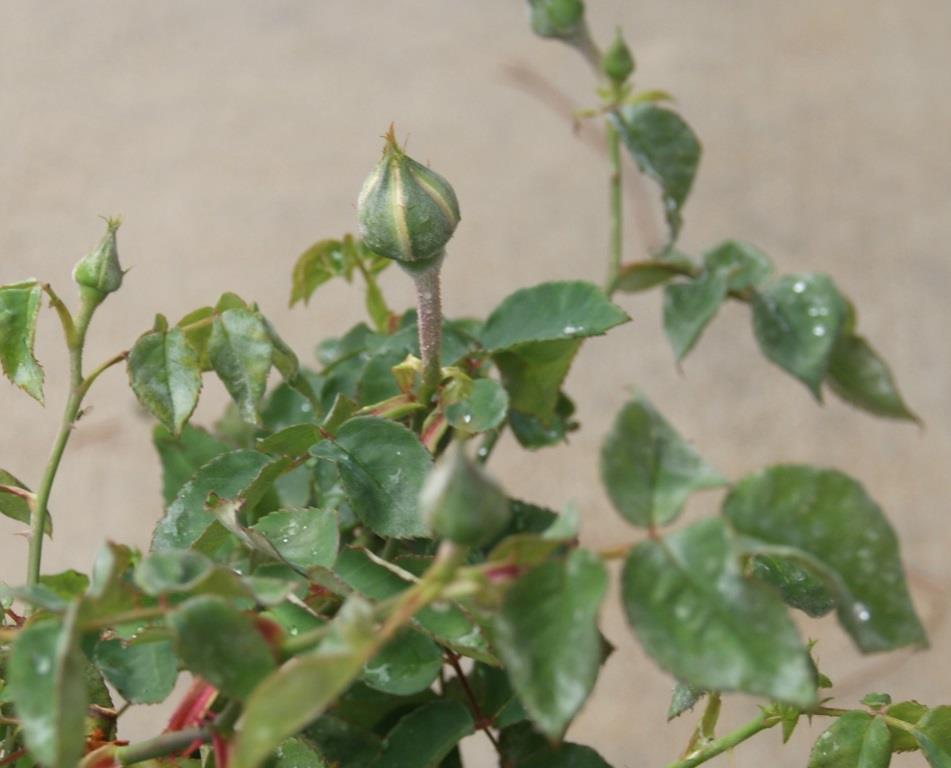
Powdery mildew on rose. Image Credit Matthew Orwat.
by Mathews Paret | Mar 25, 2014
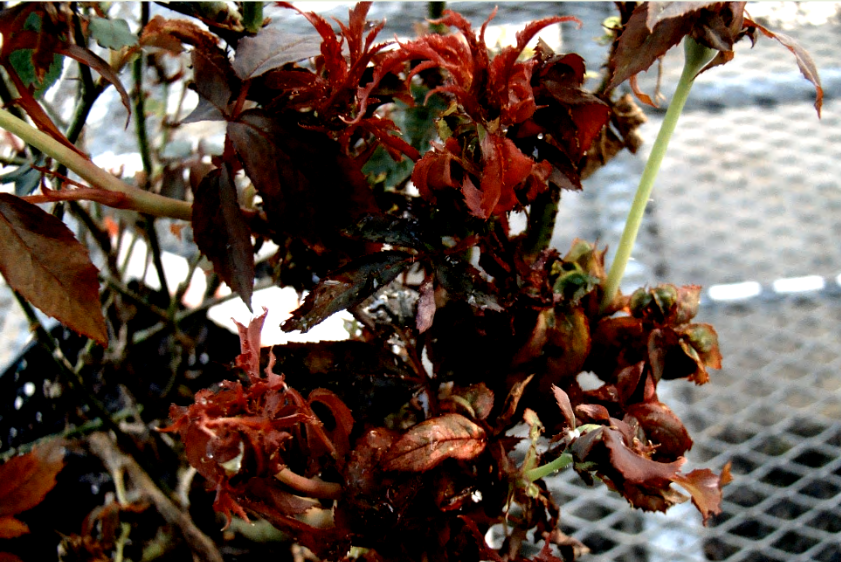
Figure 1. Witches’ broom like appearance, abnormal red discoloration of shoots and foliage, excessive thorns, distorted leaves, and deformed buds and flowers are key symptoms for the devastating Rose Rosette Disease
Roses are one of the most popular flowering shrubs in U.S. with a total wholesale value of 194 million U.S. Dollars. Among the major states in U.S., Florida is the fourth largest producer of roses with a total value exceeding 20 million U.S. Dollars. Among the major diseases on roses, Rose Rosette Disease caused by Rose Rosette Virus (RRV), an Emaravirus has been a major problem for roses in many states in the U.S during the last many years. This virus is spread by an eriophyid mite species Phyllocoptes fructiphilus. This disease was not present in Florida until November 2013, when the disease was first discovered and now confirmed in 3 Florida counties, which include one in the Panhandle. On Wednesday March 19, Horticulturists from throughout the South met at the NFREC in Quincy Florida to discuss detection and control measures that might be used to combat this viral disease.
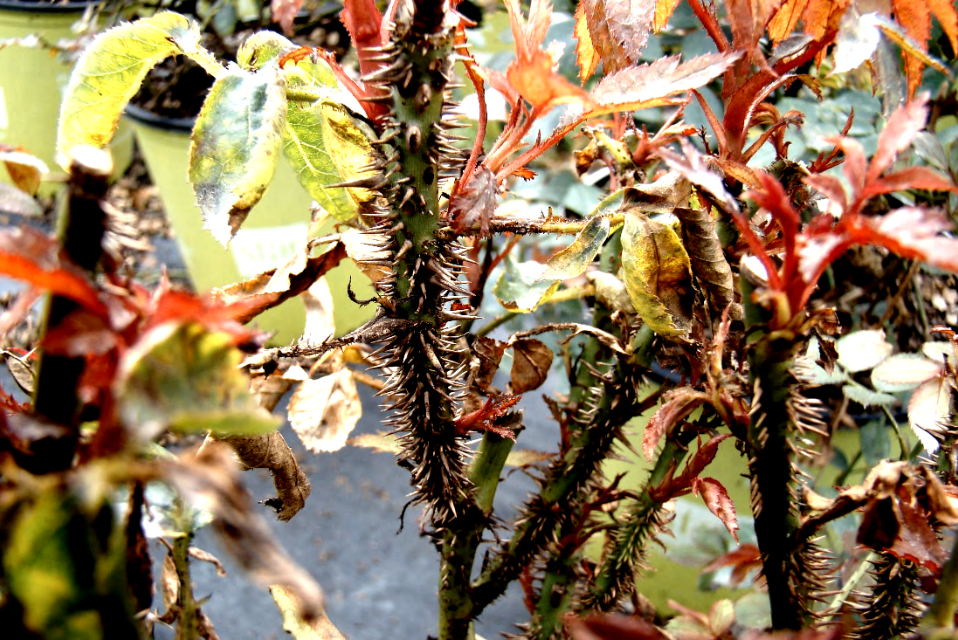
Figure 2. Severe thorn proliferation is another characteristic of rose rosette disease.
The key symptoms for Rose Rosette Disease include witches’ broom, excessive thorns, abnormal red discoloration of shoots and foliage, distorted leaves and deformed buds and flowers (click the link below for symptoms). The diseased plants usually die in 1-3 years. Considering the economic importance of the rose plants, and the highly destructive nature of the Rose rosette virus, research is currently underway by scientists at the University of Florida and the Division of Plant Industry-FDACS to develop early detection methods for the virus and management practices. This project is funded by Florida Nursery Growers and Landscape Association, and the University of Florida, IFAS Dean for Research.
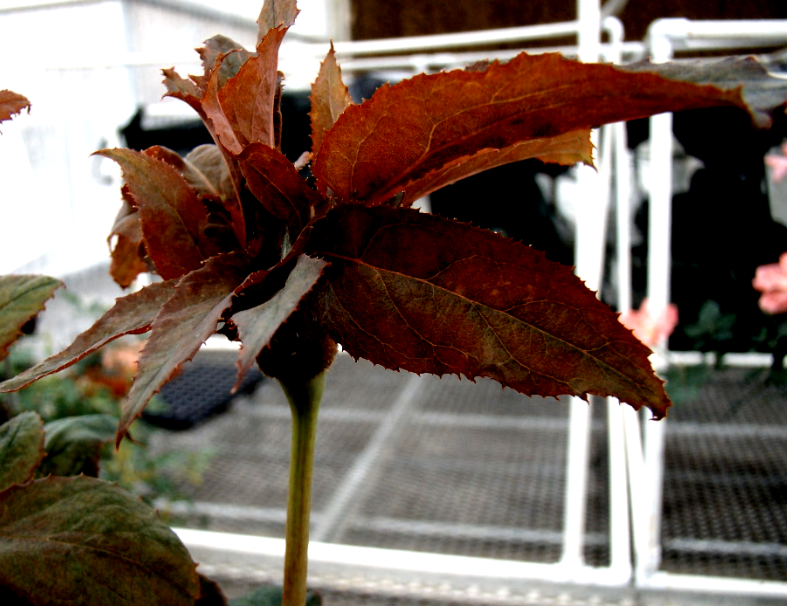
Figure 3. Distorted flower bud; leaf developing from flower bud tissue.
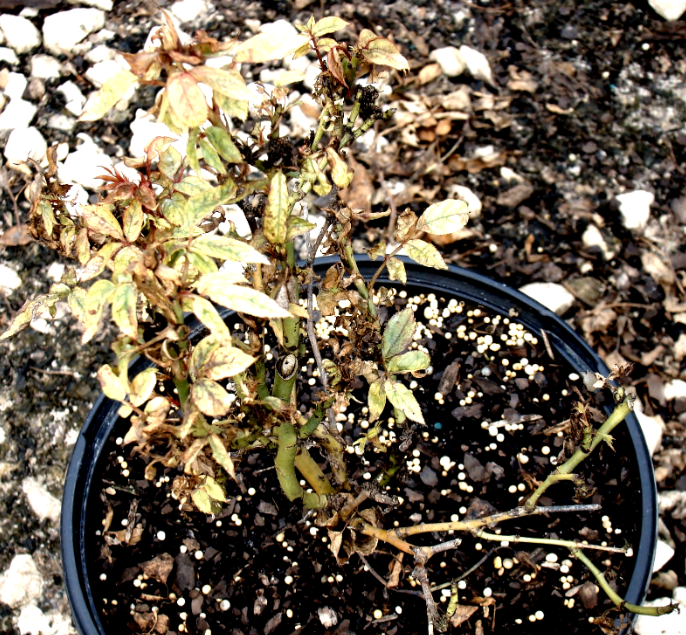
Figure 4. Severe yellowing and stunting of the plant. Infected plants usually die in 1-2 years.
How Home Gardeners and Landscape Professionals Should Respond:
-
Routine scouting and early identification. Submit samples for definitive confirmation.
-
Destroy infected plants. There is no cure for rose rosette disease. Detection will prompt a quarantine by DPI until cleaned up.
-
Eriophyid mite management in early spring is not necessary right now since it has not been found in Florida.
-
Note: The Eriophyid mite species described as the vector for RRV is not known to be present in Florida. Thus mite management recommendations are protective in nature.
Further details can be found in the links below.
U-Scout Pest Alert
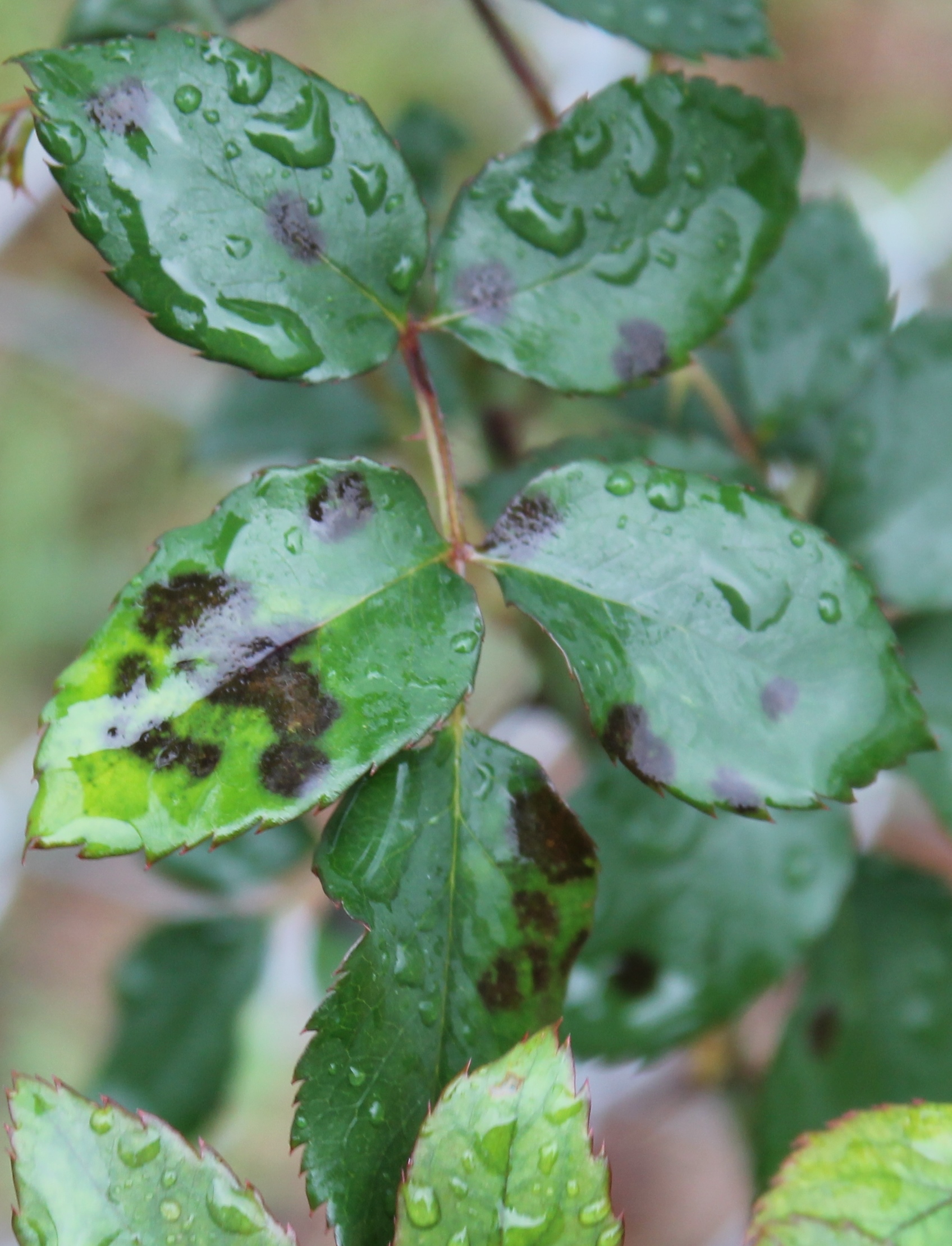
by Matthew Orwat | Mar 18, 2014
March may seem a little early to worry about fungal diseases, but recent prolonged wet weather and warmer temperatures have made the climate just right for a variety of leaf diseases in the Florida Panhandle. One in particular, Blackspot (Diplocarpon rosae), is particularly problematic for the discerning rose grower. Blackspot is just beginning to be seen this season on non-resistant rose cultivars throughout the central Florida panhandle.
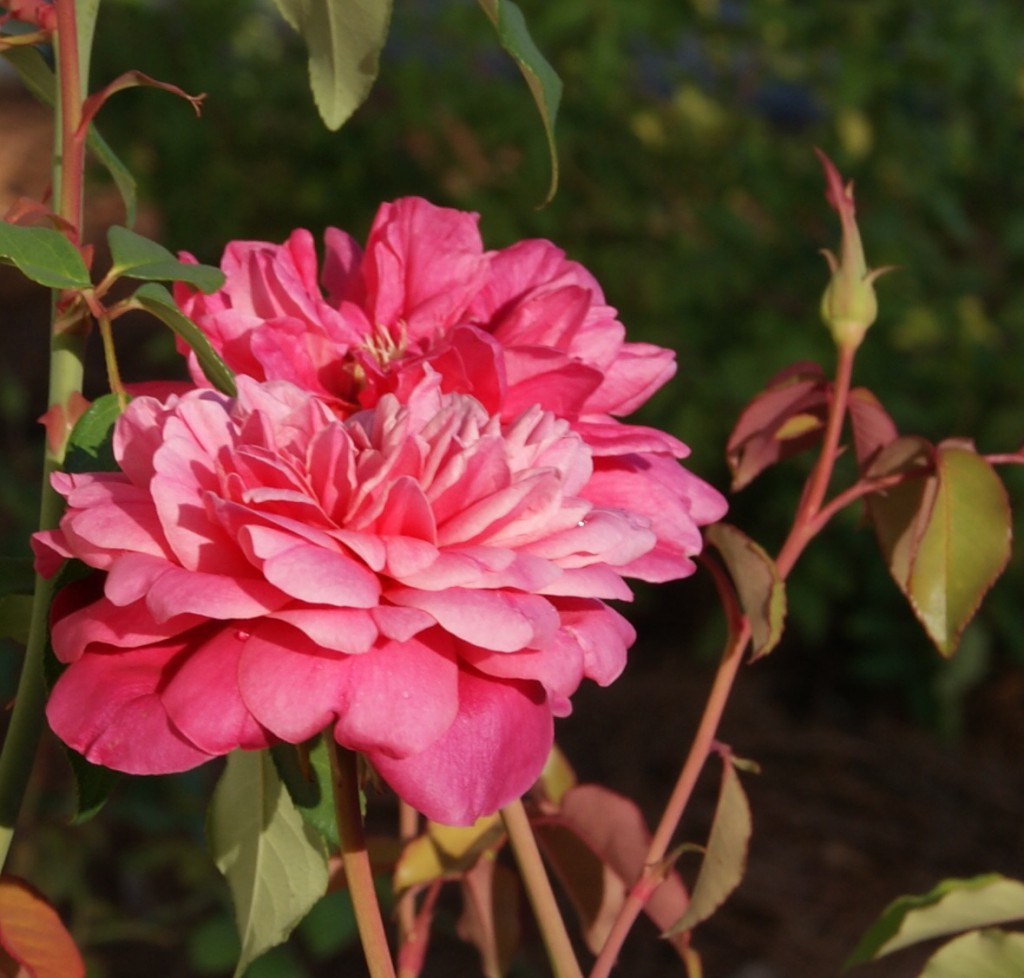
Monsieur Tillier, a rose that shows promise for blackspot resistance, is also part of the Earthkind program. Image Credit Matthew Orwat
Blackspot spores are spread from the canes or leaves of the previous season’s growth by rain or overhead irrigation. To minimize innoculum (black spot spores) remove all leaves from the previous season and any dead leaves at the base of the plant. After the annual pruning in mid to late February, it is a good idea to spray roses with sulfur or copper based fungicidal soap. This helps kill spores that have been laying dormant throughout the winter. Be careful not to spray these products when temperatures rise above 80 ° F. Doing so could burn the plants, although these products will damage tender young growth as well at temperatures below 80 ° F .
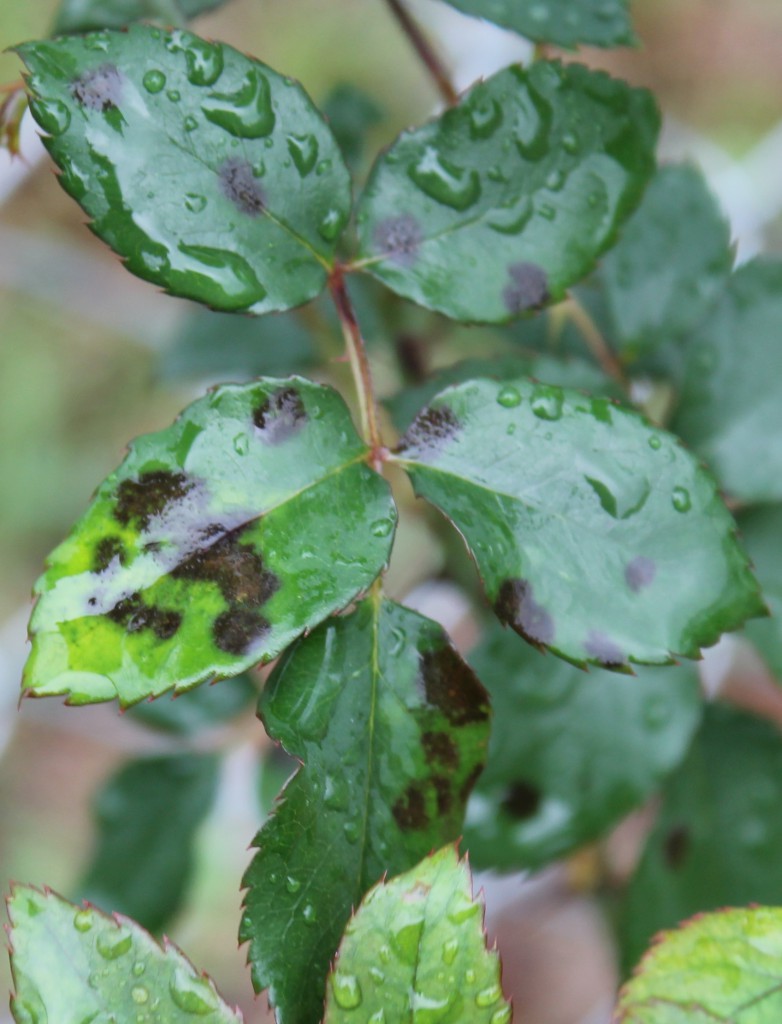
Wet, blackspot affected leaves. Image Credit Matthew Orwat
While dormant sprays often allow rose gardeners to get ahead of the disease, the best defense for the home garden is to plant resistant cultivars. There are several old and new resistant cultivars on the market. Some new resistant cultivars of note include Home Run and Knockout. Also, several older cultivars have demonstrated excellent resistance, such as Mrs. B.R. Cant and Spice. The author has been working with several older rose cultivars at the UF / IFAS Washington County Extension demonstration garden that have shown resistance during the last three years. While this demonstration garden is not a scientific study, several roses that have demonstrated some merit include Belinda’s Dream, Monsieur Tillier, Mme. Antoine Mari, Rosette Delizy and Souvenier de la Malmaison. Another resource for information on disease resistant roses is the Texas Earthkind rose program from Texas A&M University. While disease resistance is not always identical in different parts of the county, their recommended list gives the beginning rose gardener a good place to start.
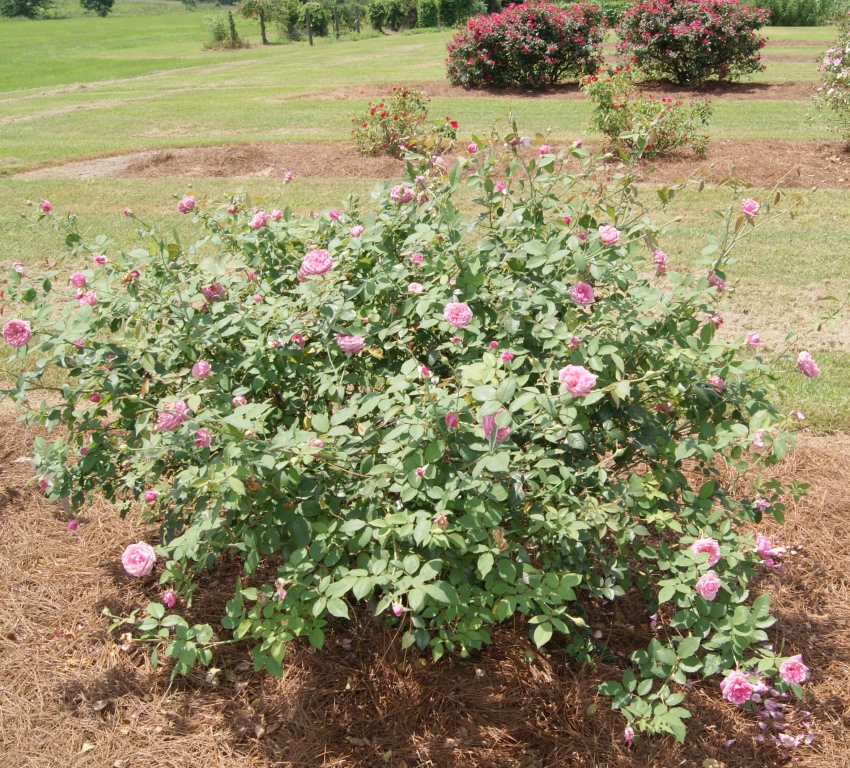
Mrs. B. R. Cant, a tea rose from 1901 has shown very good blackspot resistance at the UF IFAS rose trials in Quincy, FL. Image Credit Matthew Orwat
Several other cultural methods that will prevent spread of this disease among the rose garden include avoiding overhead irrigation, planting in well ventilated areas and proper plant spacing. These techniques attempt to make the garden environment inhospitable for blackspot proliferation.
Regardless if these management techniques are followed, if traditional large, long-stemmed, high maintenance Hybrid Tea roses are desired, most Florida rose gardeners will need to begin a spray schedule to prevent the onslaught of blackspot. Several fungicides are on the market to aid in this process, but remember that they must be used regularly (every 7-14 days) and modes of action must be rotated. This means that different types of fungicide must be rotated so that resistance to a particular fungicide by the blackspot organism does not develop. Below is a table of recommended fungicides for homeowner blackspot control. For more information, please consult the UF IFAS Extension publication P268, Blackspot of Rose.
Fungicide products marketed toward homeowners for control of black spot on roses
|
Active ingredient
|
Fungicide group
|
Trade name
|
|
Copper hydroxide
|
M1
|
Hi-Yield ® Copper |
|
Copper Sulfate
|
M1
|
Bonide® Copper Dust |
|
Copper Octanoate
|
M1
|
Bonide® Liquid Copper, Natural Guard Copper Soap, Ortho® Disease B Gon® Copper Fungicide |
|
Sulfur
|
M2
|
Bonide® Sulfur Dust, Ferti-lome® Dusting Sulfur, Green Light, Hi-Yield® Dusting Wettable Sulphur, Ortho® Bug-B-Gon® Rose & Flower Care |
|
Mancozeb
|
M3
|
Bonide® Mancozeb |
|
Captan
|
M4
|
Bonide® Captan 50WP, Hi-Yield® Captan 50W Fungicide |
|
Chlorothalonil
|
M5
|
Bonide® Fungonil, Ferti-lome® Broad Spectrum, Hi-Yield® Vegetable, Flower, Fruit and Ornamental Fungicide, Monterey, Ortho® Disease B Gon™ Garden Fungicide , Monterey Fruit Tree, Vegetable & Ornamental Fungicide |
|
Myclobutanil
|
3
|
Spectracide Immunox® Multi-Purpose Fungicide |
|
Propiconazole
|
3
|
Ferti-lome® Liquid Systemic Fungicide, Monterey Fungi-Fighter |
|
Tebuconazole
|
3
|
Bayer Advanced™ Disease Control for Roses, Flowers & Shrubs |
|
Tebuconazole + Imidacloprid
|
3 +
|
Bonide® Rose RX Systemic Drench, Feti-lome® 2-N-1 Systemic |
|
Triforine
|
3
|
Ortho® RosePride® Disease Control |
|
Calcium Polysulfide
|
NC
|
Hi-Yield® Lime Sulfur Spray |
|
Neem Oil
|
NC
|
Bonide® RX 3 in 1, Green Light® Neem Concentrate, Green Light® Rose Defense®, Monterey |
|
Acetamiprid + Triticonazole
|
NC + 3
|
Ortho® Bug B Gon® Insect & Disease Control |
|
Acephate + Resmethrin + Triforine
|
NC + NC + 3
|
Ortho® RosePride® Insect, Disease & Mite Control |
| Fungicide Group (FRAC Code): Numbers (1-37) and letters (M) are used to distinguish the fungicidal mode of action groups. All fungicides within the same group (with same number or letter) indicate same active ingredient or similar mode of action. This information must be considered in making decisions about how to manage fungicide resistance. M=Multi-site inhibitors, fungicide resistance is low; NC= not classified. Source: http://www.frac.info/ (Fungicide Resistance Action Committee, FRAC).
Always read a current product label before applying any chemicals.
|
by Gary Knox | Mar 18, 2014
Given crapemyrtle’s reputation for plant vigor and pest resistance, I was shocked to see Chinese crapemyrtles noticeably affected by a previously obscure pest.
Last November I had the privilege of traveling to China with Dave Creech (Stephen F. Austin University), Mengmeng Gu (Texas A&M) and Yan Chen (LSU-Hammond). Crapemyrtles, Lagerstroemia spp., are native to Asia, and China is regarded as the first to cultivate crapemyrtle as a flowering tree. As a crapemyrtle enthusiast, I eagerly looked forward to seeing Lagerstroemia collections in Chinese botanical gardens. What we saw in Beijing surprised us.
![Figure 1 Note the black sooty mold coating the layers of white and grey scale, believed to be crapemyrtle bark scale, Eriococcus lagerstroemiae. [Photo by Gary Knox in Beijing, China]](https://nwdistrict.ifas.ufl.edu/hort/files/2014/03/crapemyrtle-scale-768x1024.jpg)
Figure 1 Note the black sooty mold coating the layers of white and grey scale, believed to be crapemyrtle bark scale, Eriococcus lagerstroemiae. [Photo by Gary Knox in Beijing, China]
Symptoms, Appearance and Distribution in China
An early symptom of crapemyrtle bark scale is black sooty mold covering extensive areas of leaves and stems as a result of honeydew exuded by the scale. Individual scale insects are white to gray in color and ooze pink when crushed (Fig. 2). Large populations build up in branch crotches and extend up branches, appearing crusty white to gray. This scale usually is not present on new growth, leaves or slender stems unless infestations are heavy.
![Figure 2. This white to grey colored scale oozes pink when crushed. [Photo by Gary Knox in Beijing, China]](https://nwdistrict.ifas.ufl.edu/hort/files/2014/03/crapemyrtlescale2-505x1024.jpg)
Figure 2. This white to grey colored scale oozes pink when crushed. [Photo by Gary Knox in Beijing, China]
We found this scale on crapemyrtle in all four cities we visited, across hardiness zones roughly equivalent to USDA Cold Hardiness Zones 6b to 9 (Beijing, Zone 6b/7a; Nanjing, Zone 8a/8b; Shanghai, Zone 8b/9a; and Kunming, Zone 9). However, this scale was not found on all crapemyrtle. My personal observation is that stressed plants appeared more susceptible to this scale, as exemplified by infestations on freeze-damaged crapemyrtle in Beijing (Fig. 3) or in a poorly maintained planting in the Nanjing Airport parking lot. Our hosts indicated the problem appeared to be more severe on hybrid cultivars introduced from the U.S., and our observations mostly confirmed that.
In the U.S.?
Unfortunately, crapemyrtle bark scale or a similar scale may already be in the U.S. A new scale insect believed to be a species of Eriococcus was first discovered in the Dallas, Texas, area in 2010 where it is problematic on landscape crapemyrtles. It has not been definitively identified by entomologists yet and management recommendations are still being developed. However, this scale has since been observed in Shreveport, LA, Memphis, TN, and Little Rock, AR, undoubtedly being moved with plants. The expanding distribution of this scale and my personal observations of crapemyrtle bark scale throughout China suggest this scale could have a widespread and severe impact on crapemyrtles in landscapes.
![Figure 3. Dr. Gu is dismayed at seeing this crapemyrtle planting infested by scale (note the black sooty mold on stems). [Photo by Gary Knox in Beijing, China]](https://nwdistrict.ifas.ufl.edu/hort/files/2014/03/crapemyrtlescale3-767x1024.jpg)
Figure 3. Dr. Gu is dismayed at seeing this crapemyrtle planting infested by scale (note the black sooty mold on stems). [Photo by Gary Knox in Beijing, China]

















![Figure 1 Note the black sooty mold coating the layers of white and grey scale, believed to be crapemyrtle bark scale, Eriococcus lagerstroemiae. [Photo by Gary Knox in Beijing, China]](https://nwdistrict.ifas.ufl.edu/hort/files/2014/03/crapemyrtle-scale-768x1024.jpg)
![Figure 2. This white to grey colored scale oozes pink when crushed. [Photo by Gary Knox in Beijing, China]](https://nwdistrict.ifas.ufl.edu/hort/files/2014/03/crapemyrtlescale2-505x1024.jpg)
![Figure 3. Dr. Gu is dismayed at seeing this crapemyrtle planting infested by scale (note the black sooty mold on stems). [Photo by Gary Knox in Beijing, China]](https://nwdistrict.ifas.ufl.edu/hort/files/2014/03/crapemyrtlescale3-767x1024.jpg)